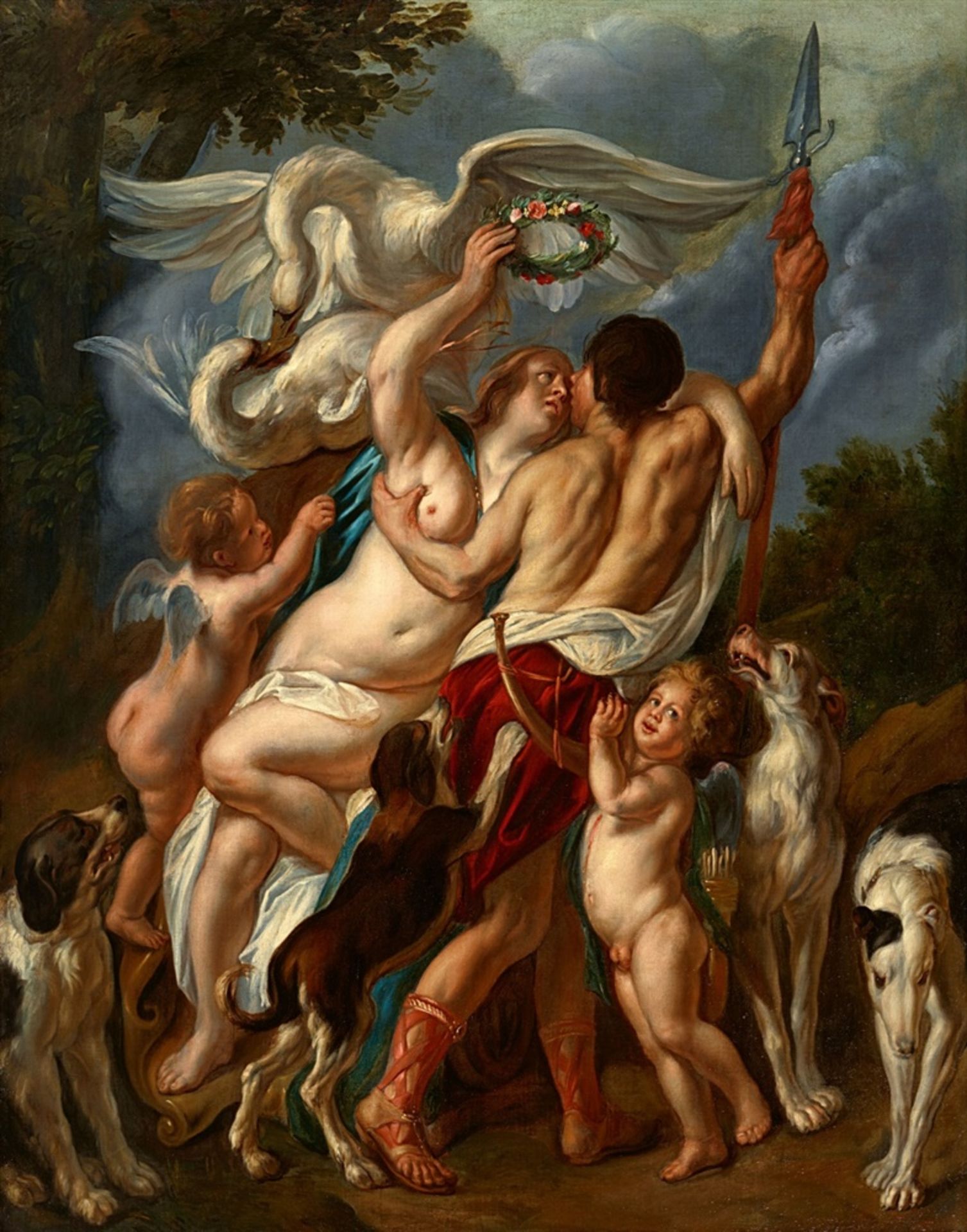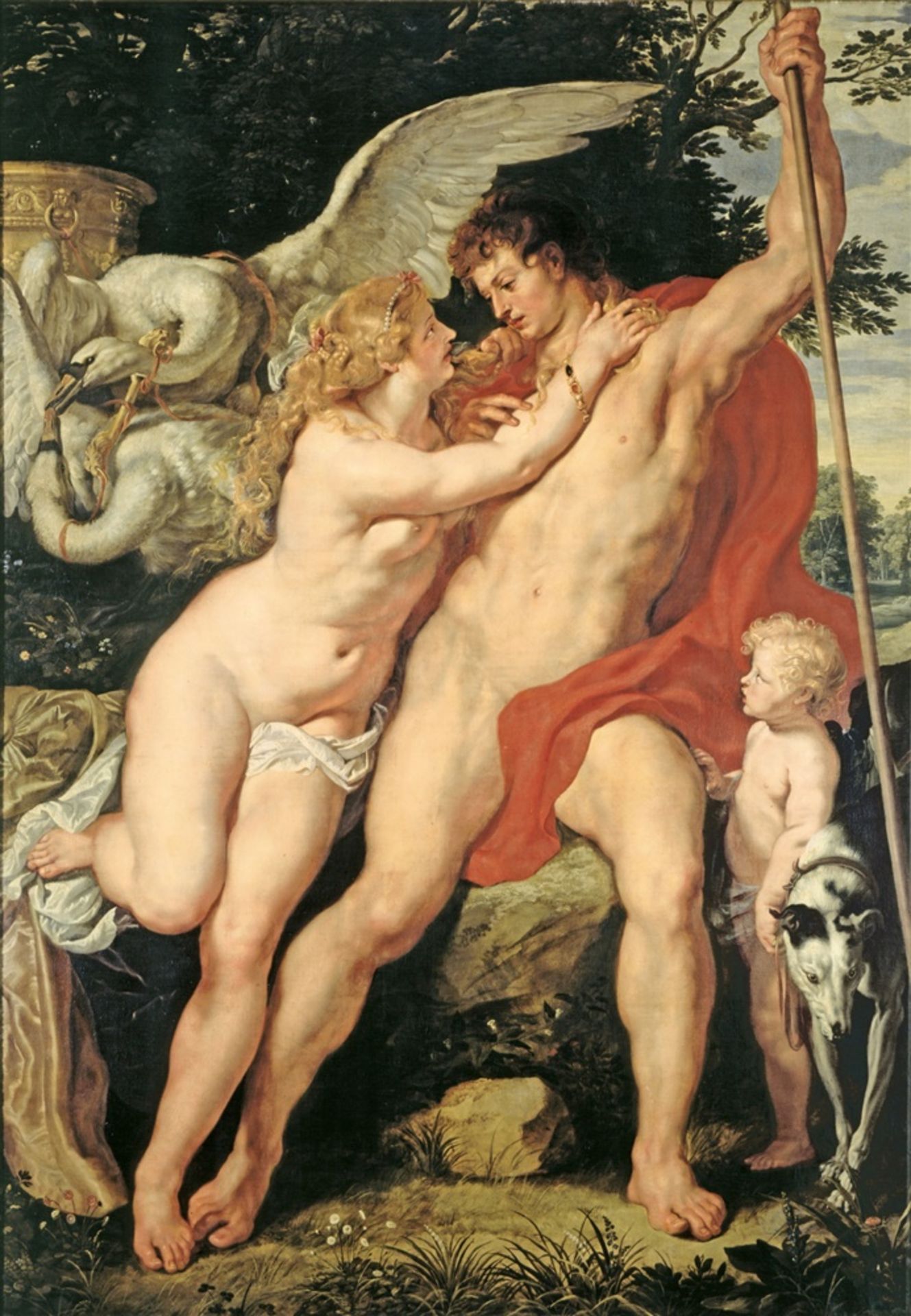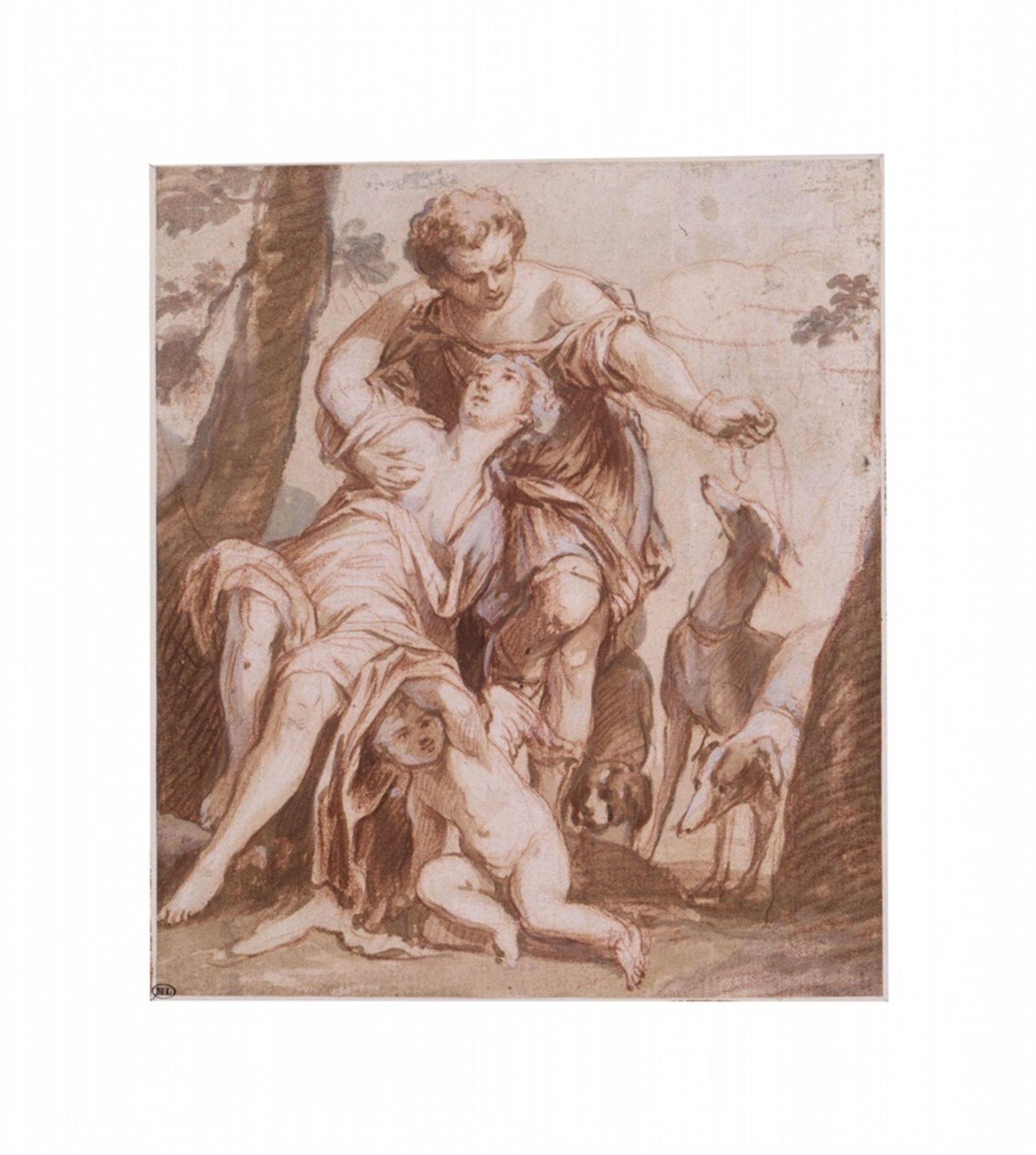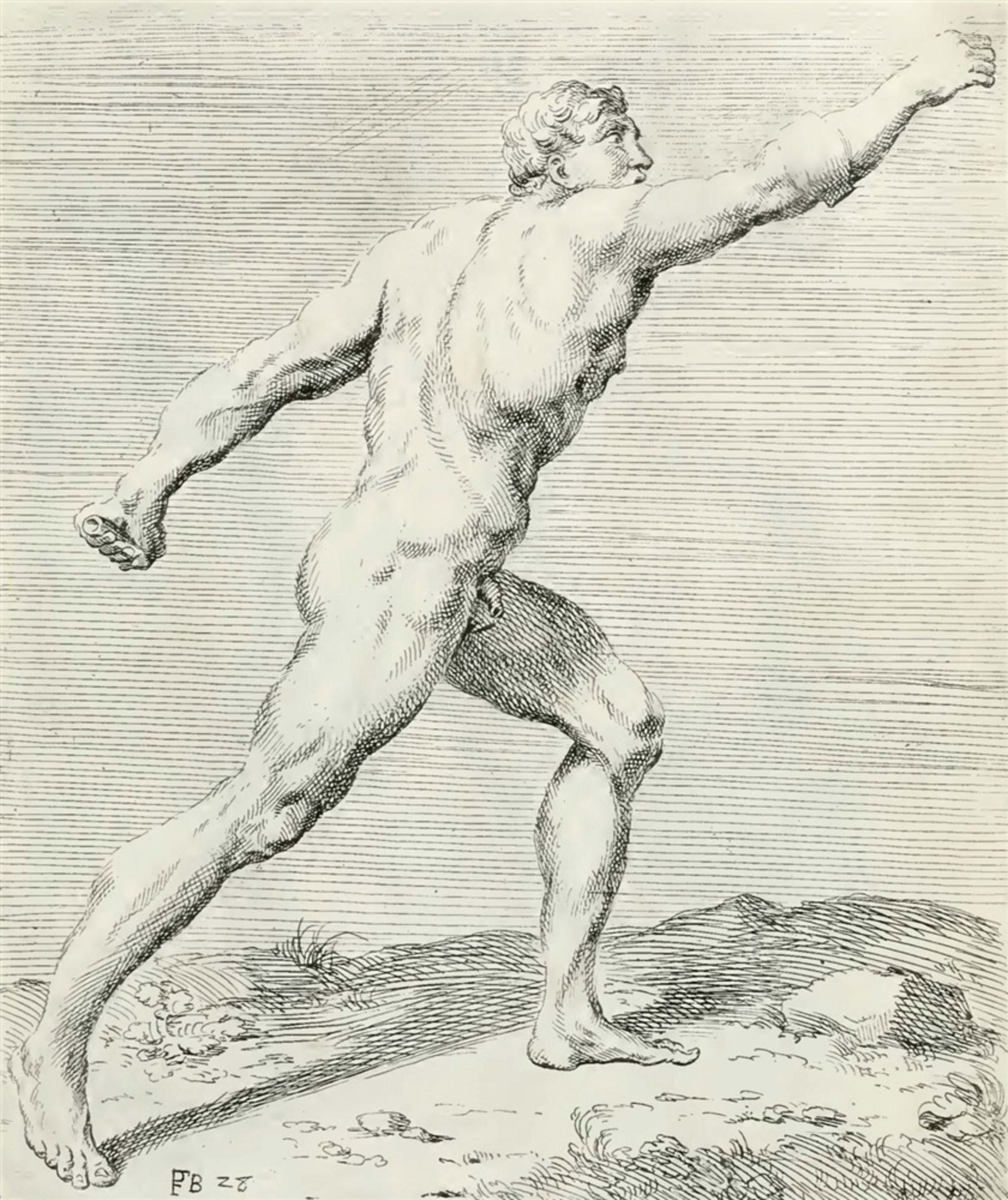2045
Jacob JordaensVenus und Adonis
Jacob Jordaens
Venus und Adonis
Öl auf Leinwand (doubliert). 195 x 153 cm.
Gutachten
Prof. Dr. Hans Vlieghe, Antwerpen, 25.9.2020.
Provenienz
Slg. Snowman. - Seine Versteigerung, Winkel & Magnussen, Kopenhagen, 24.11.1936, Lot 27. - Dänische Privatsammlung. - Auktion Bruun Rasmussen, Kopenhagen, 28.5.2019, Lot 231 (als in der Art von Peter Paul Rubens). - Dort vom jetzigen Eigentümer erworben.
Ovids X. Buch der Metamorphosen erzählt von der tragischen Beziehung zwischen der Liebesgöttin Venus und dem schönen Königssohn Adonis. Venus verliebt sich in den jungen Adonis, der trotz ihrer flehentlichen Bitten nicht von seiner Leidenschaft, der Jagd, ablassen will. So passiert das Unvermeidliche und er wird bei einer Jagd von einem Keiler tödlich verwundet. Venus vermag ihn nicht zu retten und verwandelt seine Blutstropfen in Blumen, in rote Anemonen. Jacob Jordaens zeigt den Moment, da Adonis mit dem Speer in der Hand zur Jagd aufbricht und sich aus Venus´ Umarmung löst. Venus wiederum versucht, ihn aufzuhalten und sein Haupt als Zeichen ihrer Liebe zu bekränzen. Auch der kleine Amor, der mit einem irrgeleiteten Pfeil die Liebe in Venus entflammt hat, müht sich, gemeinsam mit einem Gefährten Adonis zurückzuhalten, während die Jagdhunde diesen zum Aufbruch drängen.
Es handelt sich - das große Format und die lebensgroßen Figuren machen es deutlich -, um ein ambitioniertes Historienbild, das Jordaens zwischen 1655 und 1660 geschaffen hat und das, wie Vlieghe feststellt, „mit der warmen Tonalität und dem expressiven Pinselstrich (…) eine der feinsten Arbeiten aus Jordaens´ später Schaffensperiode“ darstellt. Jordaens nimmt sich hier eines mythologischen Themas mit einer langen, bedeutsamen Bildtradition an. Tizian prägt im 16. Jahrhundert die Darstellung des Themas für die nachfolgenden Generationen mit einem Gemälde für Philipp von Spanien, das als Teil des „Poesie“-Zyklus´ Berühmtheit erlangt. Später befassen sich Künstler wie Paolo Veronese und Peter Paul Rubens wiederholt mit dem populären mythologischen Stoff. Augenscheinlich folgt Jordaens in der Figurenkomposition seinem Lehrmeister Rubens: Vor allem dessen frühe Komposition von 1610, heute im Museum Kunstpalast Düsseldorf, dient ihm als Vorbild (Abb. 1), wie die Figurenkomposition im Ganzen, aber auch Details wie die Jagdhunde oder schnäbelnden Schwäne zeigen.
Der Vergleich der beiden Kompositionen verdeutlicht jedoch auch, dass es ein Anliegen von Jordaens ist, die Dramatik der Trennungsszene im Vergleich zu Rubens zu steigern, indem er Adonis in Rückenansicht zeigt und nicht wie Rubens in klassischer Frontalität, so dass sich Venus mit einer kraftvollen Körperdrehung zu ihm wenden muss. Dass Jordaens die Figur des Adonis als Rückenfigur darstellt ist insofern bemerkenswert, als der Gegensatz von Vorder- und Rückenansicht einen zentralen künstlerischen Aspekt bei der bildlichen Erzählung dieser Ovidschen Mythologie darstellt: So schreibt Tizian in einem berühmten Brief an Philipp von Spanien, er werde in seinem „Venus und Adonis“ die Figur der Venus von hinten zeigen, da er die Danae, die er zuvor für die „Poesie“ gemalt hat, von vorne dargestellt habe. Rubens wiederum gibt in seinen Bildern Adonis mal von vorne, mal von hinten wieder; in seiner Version aus den 1630er Jahren, heute im Metropolitan Museum of Art in New York (Inv.-Nr. 37.162), stellt auch er Adonis in Rückenansicht dar. Die verschiedenen Fassungen Veroneses schließlich zeigen, dass auch dieser immer wieder aufs Neue experimentiert, wie Venus und Adonis zueinander in Beziehung zu setzen sind.
Als Vorbild für Jordaens´ kraftvolle Rückenfigur des Adonis, in der sich der „expressive Pinselstrich“ (Hans Vlieghe) am deutlichsten zeigt, dürfte eine antike Skulptur gedient haben, der sogenannte „Gladiator Borghese“ (Musée du Louvre), eine der meistbewunderten Antiken Roms, die zu Beginn des 17. Jahrhunderts entdeckt und in der Villa Borghese als Prunkstück der Sammlung aufgestellt wurde. Jordaens scheint dabei, wie auch bei anderen Gelegenheiten, François Perriers „Segmenta nobilium signorum et statuarum“ von 1638 konsultiert zu haben, in der der „Gladiator Borghese“ - gespiegelt und verlebendigt - von allen vier Seiten gezeigt wird (Abb. 2). Ein Detail verweist zudem auf Jordaens´ Beschäftigung mit einer Vorlage Veroneses, und zwar Adonis´ Griff mit der linken Hand an Venus´ Brust. Dieses Motiv stammt von einem heute verschollenen Gemälde des Venezianers, das sich seinerzeit in der Sammlung Christina von Schwedens befand. Jordaens hat es während eines Aufenthaltes der Königin in Antwerpen gesehen und in einer Zeichnung festgehalten (Abb. 3; Musée du Louvre).
So fließen in diesem späten Meisterwerk Jordaens´ Beschäftigung mit der bedeutenden Bildtradition dieses mythologischen Themas ein, seine Beschäftigung mit den Werken Tizians, Veroneses und Rubens´, aber auch sein Interesse für die antike Kunst.
Abb. 1/Ill. 1: Peter Paul Rubens, Venus und Adonis / Venus and Adonis, Museum Kunstpalast, Dauerleihgabe der / On permanent loan from the Kunstakademie Düsseldorf © Kunstpalast - ARTOTHEK
Abb.2/Ill. 2: Gladiator Borghese, aus/from François Perrier, Segmenta nobilium signorum et statuarum etc., Rom/Paris 1638.
Abb. 3/ Ill. 3: Jakob Jordaens: Venus und Adonis nach Veronese / Venus and Adonis after Veronese © bpk / RMN - Grand Palais / Michèle Bellot
Jacob Jordaens
Venus and Adonis
Oil on canvas (relined). 195 x 153 cm.
Certificate
Prof. Dr. Hans Vlieghe, Antwerp, 25.9.2020.
Provenance
The Snowman collection. - His sale, Winkel & Magnussen, Copenhagen, 24.11.1936, lot 27. - Danish private collection. - Auctioned by Bruun Rasmussen, Copenhagen, 28.05.2019, lot 231 (as "in the manner of Peter Paul Rubens"). - Acquired there by the present owner.
This late masterpiece represents the culmination of Jacob Jordaens' enduring fascination with this great mythological subject, seamlessly fusing the influences of Titian, Veronese and Rubens, as well as the antique. The imposing format and life-size figures clearly mark this as an ambitious history painting, executed between 1655 and 1660 and which, as Hans Vlieghe has noted, is “one of the finest works from the last period of Jordaens´s activity”.
Ovid's Metamorphosis, Book X, tells of the tragic relationship between Venus, the goddess of love, and Adonis, the handsome prince. Venus falls in love with the young Adonis, who, despite her pleading, does not wish to give up his passion, hunting. The inevitable happens and he is mortally wounded by a boar on a hunt. Venus cannot save him and turns his drops of blood into flowers, red anemones. In the painting, Jordaens depicts the moment when Adonis releases himself from Venus' embrace and, spear in hand, sets off on the hunt. Venus in turn tries to stop him, crowning his head as a sign of her love. Even the little Cupid, whose misguided arrow enflamed Venus's love, struggles together with a companion to hold Adonis back whilst the hunting dogs urge him to leave.
Jordaens is exploring here a mythological theme with a long and distinguished artistic tradition. In the 16th century, Titian coined his influential depiction of this theme with a painting for Philip of Spain, which gained fame as part of the “Poesie” cycle. Later, artists such as Paolo Veronese and Peter Paul Rubens dealt repeatedly with t
Full description on lot-tissimo.com
Jacob Jordaens
Venus und Adonis
Öl auf Leinwand (doubliert). 195 x 153 cm.
Gutachten
Prof. Dr. Hans Vlieghe, Antwerpen, 25.9.2020.
Provenienz
Slg. Snowman. - Seine Versteigerung, Winkel & Magnussen, Kopenhagen, 24.11.1936, Lot 27. - Dänische Privatsammlung. - Auktion Bruun Rasmussen, Kopenhagen, 28.5.2019, Lot 231 (als in der Art von Peter Paul Rubens). - Dort vom jetzigen Eigentümer erworben.
Ovids X. Buch der Metamorphosen erzählt von der tragischen Beziehung zwischen der Liebesgöttin Venus und dem schönen Königssohn Adonis. Venus verliebt sich in den jungen Adonis, der trotz ihrer flehentlichen Bitten nicht von seiner Leidenschaft, der Jagd, ablassen will. So passiert das Unvermeidliche und er wird bei einer Jagd von einem Keiler tödlich verwundet. Venus vermag ihn nicht zu retten und verwandelt seine Blutstropfen in Blumen, in rote Anemonen. Jacob Jordaens zeigt den Moment, da Adonis mit dem Speer in der Hand zur Jagd aufbricht und sich aus Venus´ Umarmung löst. Venus wiederum versucht, ihn aufzuhalten und sein Haupt als Zeichen ihrer Liebe zu bekränzen. Auch der kleine Amor, der mit einem irrgeleiteten Pfeil die Liebe in Venus entflammt hat, müht sich, gemeinsam mit einem Gefährten Adonis zurückzuhalten, während die Jagdhunde diesen zum Aufbruch drängen.
Es handelt sich - das große Format und die lebensgroßen Figuren machen es deutlich -, um ein ambitioniertes Historienbild, das Jordaens zwischen 1655 und 1660 geschaffen hat und das, wie Vlieghe feststellt, „mit der warmen Tonalität und dem expressiven Pinselstrich (…) eine der feinsten Arbeiten aus Jordaens´ später Schaffensperiode“ darstellt. Jordaens nimmt sich hier eines mythologischen Themas mit einer langen, bedeutsamen Bildtradition an. Tizian prägt im 16. Jahrhundert die Darstellung des Themas für die nachfolgenden Generationen mit einem Gemälde für Philipp von Spanien, das als Teil des „Poesie“-Zyklus´ Berühmtheit erlangt. Später befassen sich Künstler wie Paolo Veronese und Peter Paul Rubens wiederholt mit dem populären mythologischen Stoff. Augenscheinlich folgt Jordaens in der Figurenkomposition seinem Lehrmeister Rubens: Vor allem dessen frühe Komposition von 1610, heute im Museum Kunstpalast Düsseldorf, dient ihm als Vorbild (Abb. 1), wie die Figurenkomposition im Ganzen, aber auch Details wie die Jagdhunde oder schnäbelnden Schwäne zeigen.
Der Vergleich der beiden Kompositionen verdeutlicht jedoch auch, dass es ein Anliegen von Jordaens ist, die Dramatik der Trennungsszene im Vergleich zu Rubens zu steigern, indem er Adonis in Rückenansicht zeigt und nicht wie Rubens in klassischer Frontalität, so dass sich Venus mit einer kraftvollen Körperdrehung zu ihm wenden muss. Dass Jordaens die Figur des Adonis als Rückenfigur darstellt ist insofern bemerkenswert, als der Gegensatz von Vorder- und Rückenansicht einen zentralen künstlerischen Aspekt bei der bildlichen Erzählung dieser Ovidschen Mythologie darstellt: So schreibt Tizian in einem berühmten Brief an Philipp von Spanien, er werde in seinem „Venus und Adonis“ die Figur der Venus von hinten zeigen, da er die Danae, die er zuvor für die „Poesie“ gemalt hat, von vorne dargestellt habe. Rubens wiederum gibt in seinen Bildern Adonis mal von vorne, mal von hinten wieder; in seiner Version aus den 1630er Jahren, heute im Metropolitan Museum of Art in New York (Inv.-Nr. 37.162), stellt auch er Adonis in Rückenansicht dar. Die verschiedenen Fassungen Veroneses schließlich zeigen, dass auch dieser immer wieder aufs Neue experimentiert, wie Venus und Adonis zueinander in Beziehung zu setzen sind.
Als Vorbild für Jordaens´ kraftvolle Rückenfigur des Adonis, in der sich der „expressive Pinselstrich“ (Hans Vlieghe) am deutlichsten zeigt, dürfte eine antike Skulptur gedient haben, der sogenannte „Gladiator Borghese“ (Musée du Louvre), eine der meistbewunderten Antiken Roms, die zu Beginn des 17. Jahrhunderts entdeckt und in der Villa Borghese als Prunkstück der Sammlung aufgestellt wurde. Jordaens scheint dabei, wie auch bei anderen Gelegenheiten, François Perriers „Segmenta nobilium signorum et statuarum“ von 1638 konsultiert zu haben, in der der „Gladiator Borghese“ - gespiegelt und verlebendigt - von allen vier Seiten gezeigt wird (Abb. 2). Ein Detail verweist zudem auf Jordaens´ Beschäftigung mit einer Vorlage Veroneses, und zwar Adonis´ Griff mit der linken Hand an Venus´ Brust. Dieses Motiv stammt von einem heute verschollenen Gemälde des Venezianers, das sich seinerzeit in der Sammlung Christina von Schwedens befand. Jordaens hat es während eines Aufenthaltes der Königin in Antwerpen gesehen und in einer Zeichnung festgehalten (Abb. 3; Musée du Louvre).
So fließen in diesem späten Meisterwerk Jordaens´ Beschäftigung mit der bedeutenden Bildtradition dieses mythologischen Themas ein, seine Beschäftigung mit den Werken Tizians, Veroneses und Rubens´, aber auch sein Interesse für die antike Kunst.
Abb. 1/Ill. 1: Peter Paul Rubens, Venus und Adonis / Venus and Adonis, Museum Kunstpalast, Dauerleihgabe der / On permanent loan from the Kunstakademie Düsseldorf © Kunstpalast - ARTOTHEK
Abb.2/Ill. 2: Gladiator Borghese, aus/from François Perrier, Segmenta nobilium signorum et statuarum etc., Rom/Paris 1638.
Abb. 3/ Ill. 3: Jakob Jordaens: Venus und Adonis nach Veronese / Venus and Adonis after Veronese © bpk / RMN - Grand Palais / Michèle Bellot
Jacob Jordaens
Venus and Adonis
Oil on canvas (relined). 195 x 153 cm.
Certificate
Prof. Dr. Hans Vlieghe, Antwerp, 25.9.2020.
Provenance
The Snowman collection. - His sale, Winkel & Magnussen, Copenhagen, 24.11.1936, lot 27. - Danish private collection. - Auctioned by Bruun Rasmussen, Copenhagen, 28.05.2019, lot 231 (as "in the manner of Peter Paul Rubens"). - Acquired there by the present owner.
This late masterpiece represents the culmination of Jacob Jordaens' enduring fascination with this great mythological subject, seamlessly fusing the influences of Titian, Veronese and Rubens, as well as the antique. The imposing format and life-size figures clearly mark this as an ambitious history painting, executed between 1655 and 1660 and which, as Hans Vlieghe has noted, is “one of the finest works from the last period of Jordaens´s activity”.
Ovid's Metamorphosis, Book X, tells of the tragic relationship between Venus, the goddess of love, and Adonis, the handsome prince. Venus falls in love with the young Adonis, who, despite her pleading, does not wish to give up his passion, hunting. The inevitable happens and he is mortally wounded by a boar on a hunt. Venus cannot save him and turns his drops of blood into flowers, red anemones. In the painting, Jordaens depicts the moment when Adonis releases himself from Venus' embrace and, spear in hand, sets off on the hunt. Venus in turn tries to stop him, crowning his head as a sign of her love. Even the little Cupid, whose misguided arrow enflamed Venus's love, struggles together with a companion to hold Adonis back whilst the hunting dogs urge him to leave.
Jordaens is exploring here a mythological theme with a long and distinguished artistic tradition. In the 16th century, Titian coined his influential depiction of this theme with a painting for Philip of Spain, which gained fame as part of the “Poesie” cycle. Later, artists such as Paolo Veronese and Peter Paul Rubens dealt repeatedly with t
Full description on lot-tissimo.com
Alte Kunst / Old Masters
Auktionsdatum
Ort der Versteigerung
Für Kunsthaus Lempertz Versandinformtation bitte wählen Sie +49 (0)221 9257290.
Wichtige Informationen
Zu Aufgeld und Mehrwertsteuer prüfen Sie bitte das jeweilige Los.
For buyer’s premium and VAT please check particular lot.
AGB
standard | standard
Conditions of Sale
1. The art auction house, Kunsthaus Lempertz KG (henceforth referred to as Lempertz), conducts public auctions in terms of § 383 paragraph 3 sentence 1 of the Civil Code as commissioning agent on behalf of the accounts of submitters, who remain anonymous. With regard to its auctioneering terms and conditions drawn up in other languages, the German version remains the official one.
2. The auctioneer reserves the right to divide or combine any catalogue lots or, if it has special reason to do so, to offer any lot for sale in an order different from that given in the catalogue or to withdraw any lot from the sale.
3. All lots put up for sale may be viewed and inspected prior to the auction. The catalogue specifications and related specifications appearing on the internet, which have both been compiled in good conscience, do not form part of the contractually agreed to conditions. These specifications have been derived from the status of the information available at the time of compiling the catalogue. They do not serve as a guarantee in legal terms and their purpose is purely in the information they provide. The same applies to any reports on an item’s condition or any other information, either in oral or written form. Certificates or certifications from artists, their estates or experts relevant to each case only form a contractual part of the agreement if they are specifically mentioned in the catalogue text. The state of the item is generally not mentioned in the catalogue. Likewise missing specifications do not constitute an agreement on quality. All items are used goods.
4. Warranty claims are excluded. In the event of variances from the catalogue descriptions, which result in negation or substantial diminution of value or suitability, and which are reported with due justification within one year after handover, Lempertz nevertheless undertakes to pursue its rights against the seller through the courts; in the event of a successful claim against the seller, Lempertz will reimburse the buyer only the total purchase price paid. Over and above this, Lempertz undertakes to reimburse its commission within a given period of three years after the date of the sale if the object in question proves not to be authentic.
5. Claims for compensation as the result of a fault or defect in the object auctioned or damage to it or its loss, regardless of the legal grounds, or as the result of variances from the catalogue description or statements made elsewhere are excluded unless Lempertz acted with wilful intent or gross negligence; the liability for bodily injury or damages caused to health or life remains unaffected. In other regards, point 4 applies.
6. Submission of bids. Bids in attendance: The floor bidder receives a bidding number on presentation of a photo ID. Lempertz reserves the right to grant entry to the auction. If the bidder is not known to Lempertz, registration must take place 24 hours before the auction is due to begin in writing on presentation of a current bank reference. Bids in absentia: Bids can also be submitted either in writing, telephonically or via the internet. The placing of bids in absentia must reach Lempertz 24 hours before the auction to ensure the proper processing thereof. The item must be mentioned in the bid placed, together with the lot number and item description. In the event of ambiguities, the listed lot number becomes applicable. The placement of a bid must be signed by the applicant. The regulations regarding revocations and the right to return the goods in the case of long distance agreements (§ 312b-d of the Civil Code) do not apply. Telephone bids: Establishing and maintaining a connection cannot be vouched for. In submitting a bid placement, the bidder declares that he agrees to the recording of the bidding process. Bids via the internet: They will only be accepted by Lempertz if the bidder registered himself on the internet website beforehand. Lempertz will treat such bids in the same way as bids in writing.
7. Carrying out the auction: The hammer will come down when no higher bids are submitted after three calls for a bid. In extenuating circumstances, the auctioneer reserves the right to bring down the hammer or he can refuse to accept a bid. If several individuals make the same bid at the same time, and after the third call, no higher bid ensues, then the ticket becomes the deciding factor. The auctioneer can retract his acceptance of the bid and auction the item once more if a higher bid that was submitted on time, was erroneously overlooked and immediately queried by the bidder, or if any doubts regarding its acceptance arise. Written bids are only played to an absolute maximum by Lempertz if this is deemed necessary to outbid
another bid. The auctioneer can bid on behalf of the submitter up to the agreed limit, without revealing this and irrespective of whether other bids are submitted. Even if bids have been placed and the hammer has not come down, the auctioneer is only liable to the bidder in the event of premeditation or gross negligence.
8. Once a lot has been knocked down, the successful bidder is obliged to buy it. If a bid is accepted conditionally, the bidder is bound by his bid until four weeks after the auction unless he immediately withdraws from the conditionally accepted bid. From the fall of the hammer, possession and risk pass directly to the buyer, while ownership passes to the buyer only after full payment has been received.
9. Up to a hammer price of € 400,000 a premium of 24 % calculated on the hammer price plus 19 % value added tax (VAT) calculated on the premium only is levied. The premium will be reduced to 20 % (plus VAT) on any amount surpassing € 400,000 (margin scheme). On lots which are characterized by N, an additional 7 % for import tax will be charged. On lots which are characterized by an D, 35% is calculated on the hammer price (24% buyer´s premium + 19% VAT on the premium only + import tax). 31% is calculated on the amount surpassing € 400.000. The D objects contain all taxes, and tehy can not be carried away immediately. On lots which are characterized by an R, the buyer shall pay a premium of 24 % on the hammer price up to € 400,000 and 20 % on the surpassing amount; onto this (hammer price and premium) the statutory VAT of 19 % will be added (regular scheme). Exports to third (i.e. non-EU) countries will be exempt from VAT, and so will be exports made by companies from other EU member states if they state their VAT identification number. For original works of art, whose authors are either still alive or died after 31.12.1948, a charge of 1.8 % on the hammer price will be levied for the droit de suite. The maximum charge is € 12,500. If a buyer exports an object to a third country personally, the VAT will be refunded, as soon as Lempertz receives the export and import papers. All invoices issued on the day of auction or soon after remain under provision.
10. Successful bidders attending the auction in person shall forthwith upon the purchase pay to Lempertz the final price (hammer price plus premium and VAT) in Euro. Payments by foreign buyers who have bid in writing or by proxy shall also be due forthwith upon the purchase, but will not be deemed to have been delayed if received within ten days of the invoice date. Bank transfers are to be exclusively in Euros. The request for an alteration of an auction invoice to a person other than the bidder has to be made immediately after the auction. Lempertz however reserves the right to refuse such a request if it is deemed appropriate.
11. In the case of payment default, Lempertz will charge 1% interest on the outstanding amount of the gross price per month.. If the buyer defaults in payment, Lempertz may at its discretion insist on performance of the purchase contract or, after allowing a period of grace, claim damages for non-performance. In the latter case, Lempertz may determine the amount of the damages by putting the lot or lots up for auction again, in which case the defaulting buyer will bear the amount of any reduction in the proceeds compared with the earlier auction, plus the cost of resale, including the premium.
12. Buyers must take charge of their purchases immediately after the auction. Once a lot has been sold, the auctioneer is liable only for wilful intent or gross negligence. Lots will not, however, be surrendered to buyers until full payment has been received. Without exception, shipment will be at the expense and risk of the buyer. Purchases which are not collected within four weeks after the auction may be stored and insured by Lempertz on behalf of the buyer and at its expense in the premises of a freight agent. If Lempertz stores such items itself, it will charge 1 % of the hammer price for insurance and storage costs.
13. As far as this can be agreed, the place of performance and jurisdiction is Cologne. German law applies; the German law for the protection of cultural goods applies; the provisions of the United Nations Convention on Contracts for the International Sale of Goods (CISG) are not applicable. Should any provision herein be wholly or partially ineffective, this will not affect the validity of the remaining provisions.
Henrik Hanstein, sworn public auctioneer
Takuro Ito, Kilian Jay von Seldeneck, auctioneers













